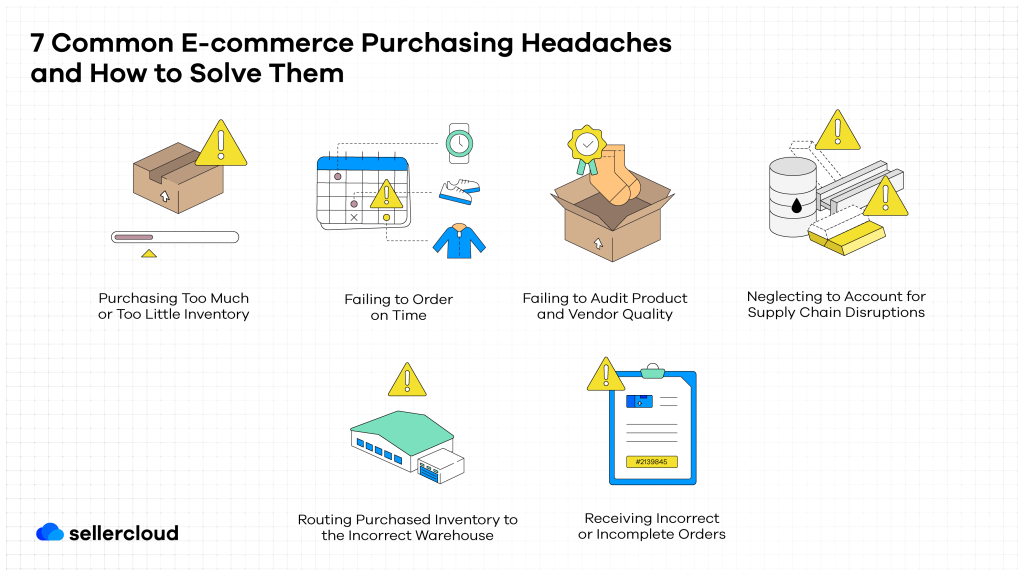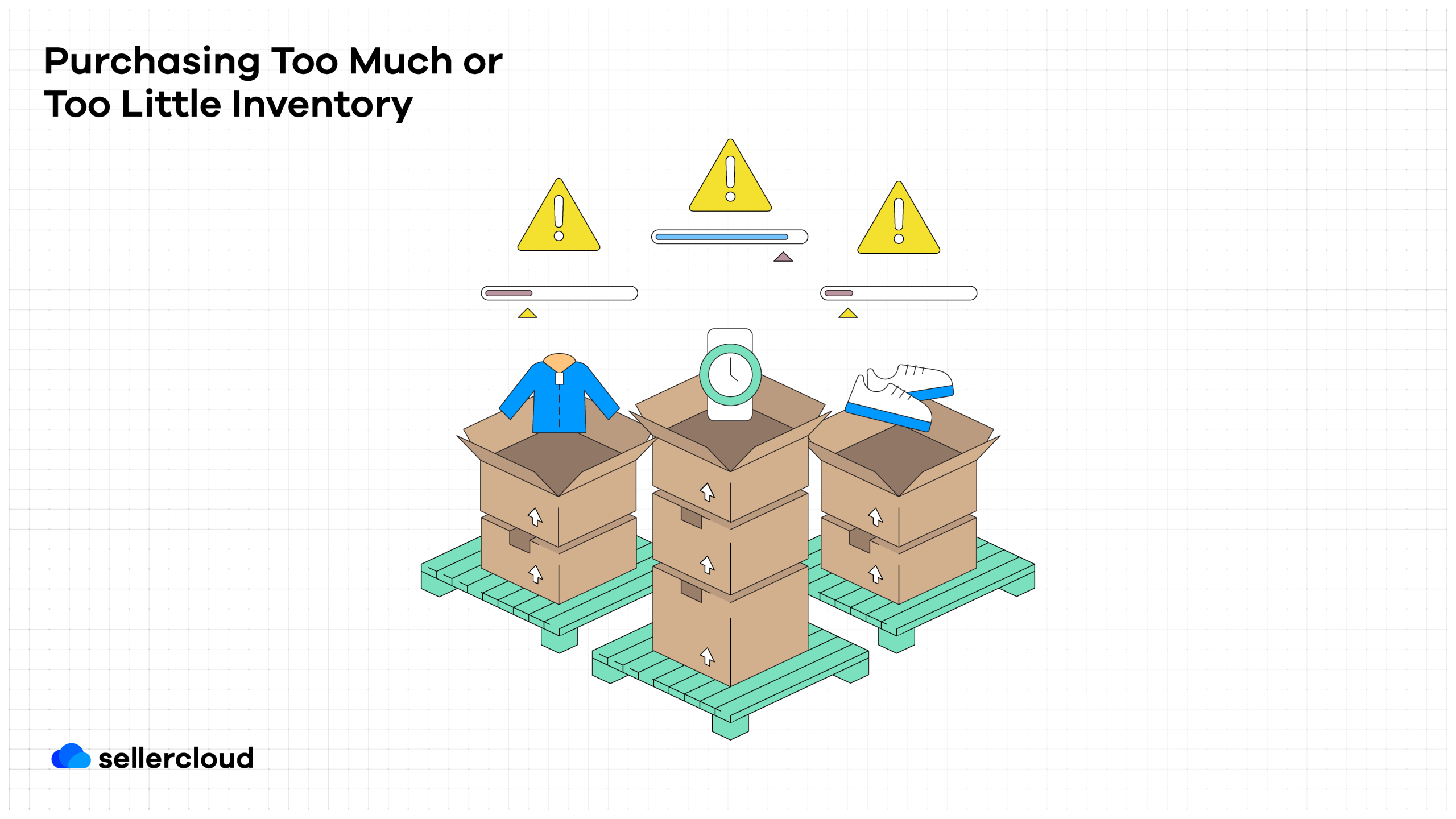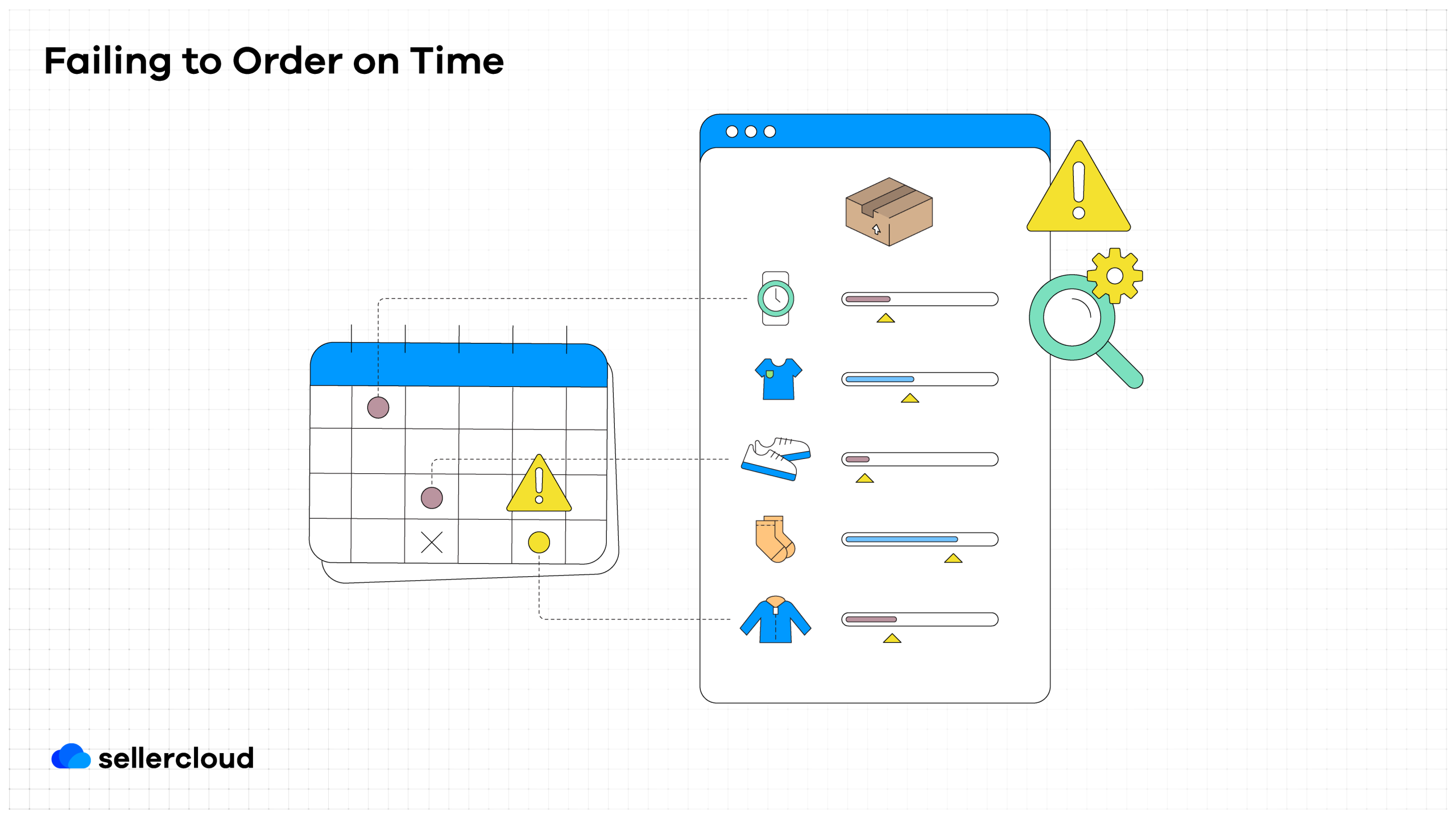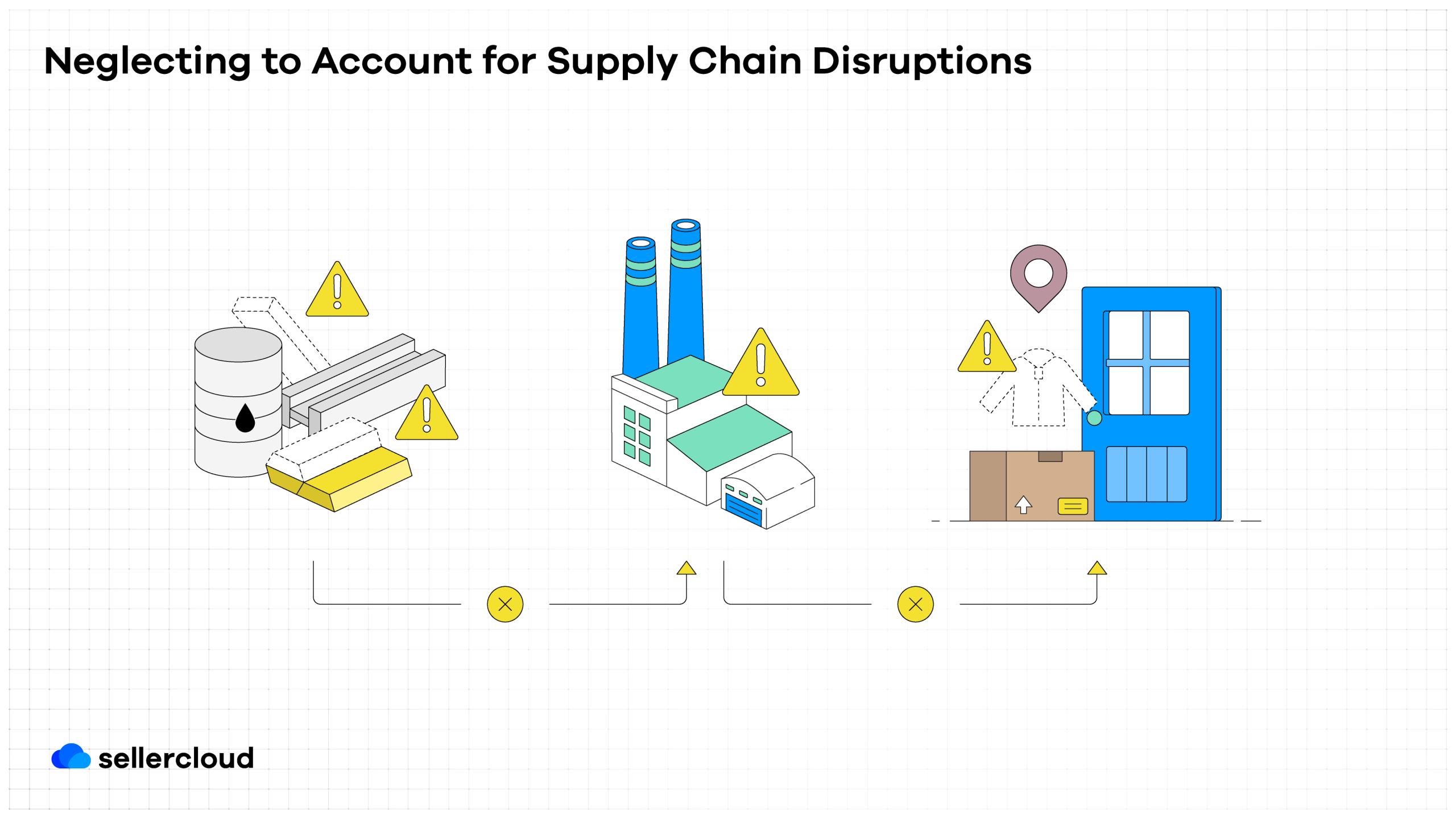
You can’t have an omnichannel ecommerce brand without products to sell. A clear and efficient purchasing workflow is essential to ensuring that you always have the inventory you need to meet customer demand.
It may seem straightforward: Place purchase orders (POs) to obtain the supplies, materials, and products you need, list products for sale, and fulfill orders. In reality, there are many pain points in the purchasing process that can completely upend that simplicity.
Thankfully, there are ways to plan for these purchasing headaches and prevent them from negatively impacting your bottom line.
1. Purchasing Too Little Inventory
The Problem: You ordered inventory to replenish your supply, but you didn’t order enough. An inventory purchase that is too small means that you will end up reordering again in the not-too-distant future. Worse, it could leave you with insufficient quantities to fulfill pending customer orders.
Having to make frequent, smaller orders can seriously damage your cost of goods sold (COGS) and profit margin calculations. Not only could you miss out on volume discounts that suppliers and vendors commonly offer for larger orders, but you could also end up paying more frequent (and expensive) shipping costs.
The Solution: The obvious answer is to purchase larger quantities. However, blindly purchasing too much inventory can also cause issues (more on this later). Instead, you should be able to settle on the ideal PO quantities using business intelligence data, demand forecasting, and predictive purchasing tools.
Part of these considerations should include the quantity thresholds that allow you to take advantage of bulk purchasing and optimal shipping rates. Sometimes, sellers are reluctant to order large quantities because they simply do not have the space to store the inventory. While this is a rational concern, it can be overcome in several ways.
The first option would be to invest in additional warehouse space. Even if you already have a warehouse location (or a few), adding additional warehouses can be a benefit to both increase your storage and increase your logistical reach.
The other option would be to enlist the help of a third-party logistics (3PL) provider. You can forward your inventory to these partners, who can process and fulfill orders on your behalf—all from their warehouses and distribution facilities. This can be a helpful workaround if space prevents you from purchasing and storing sufficient inventory.
 2. Purchasing Too Much Inventory
2. Purchasing Too Much Inventory
The Problem: In an effort to avoid out-of-stocks, you order excessive amounts of inventory. This winds up creating other issues for your ecommerce business to contend with. It is worth noting that the resulting costs can quickly erase the benefits of high-volume purchasing once that inventory is on hand.
Storing inventory—whether in your warehouse or someone else’s—comes with carrying costs. The more inventory you hold, the higher your expenses for things like taxes, insurance, employee costs, and storage costs. It also takes up valuable space that could be used for additional SKUs, workspaces, and/or more flexible warehouse layouts.
Carrying too much inventory can also cause issues if you sell products with expiration dates. Having to discard unsellable products is a waste of both time and resources that your business can do without.
The Solution: Just like when trying to avoid purchasing too little inventory, making data-driven decisions based on historical data and customer behavior can help you zero in on the sweet spot of how much inventory is enough without becoming excessive.
Again, a reliable omnichannel inventory management platform can help you identify the inventory you need to be prepared to meet demand across all your selling channels. This can also help you avoid the dreaded bullwhip effect, which occurs when overreactions to customer demand result in costly purchasing quantity errors.
3. Failing to Order on Time
The Problem: You can’t sell inventory you don’t have. Once you know how much inventory you need to purchase, the key is to know when the right time to order it is. Order too soon, and you end up with additional carrying costs and excess inventory you may not need; order too late, and you wind up with backorders and cancellations that can damage your reputation with customers and your standing on third-party marketplaces.
Then there’s turnaround time. Depending on the suppliers, manufacturers, and shipping carriers involved in fulfilling your PO, there may be delays between placing the PO and receiving your purchases. This adds up to timing being one of the most critical components of effective ecommerce purchasing practices.
The Solution: While there is no possible way to account for every unknown in the timeline of a PO’s fulfillment, you can use data to err on the side of caution and ensure that you are never left empty-handed. Predictive purchasing tools use historical data and customer trends to notify sellers when it’s time to place a PO and re-up their stock.
Taking a step further, Descartes Sellercloud’s predictive purchasing features allow sellers to automate PO creation, further streamlining the purchasing process and avoiding the pitfalls of running out of inventory.
 4. Failing to Audit Product and Vendor Quality
4. Failing to Audit Product and Vendor Quality
The Problem: You assume that all vendors are created equal, but find out (the hard way) that they aren’t. If a PO (or several) is bungled, you will not have the necessary inventory to meet customers’ demands. Just because you submit a PO doesn’t mean it will be handled quickly, accurately, and with the care your business deserves.
The Solution: Establish criteria for regular vendor quality evaluations. This can include product quality, packaging, timeliness, corporate reputation, data security, and other possible risks that could negatively impact your business, brand, and reputation. While this is particularly important for assessing suppliers, it is a best practice to regularly audit your critical vendors to minimize third-party risk.
5. Neglecting to Account for Supply Chain Disruptions
The Problem: You are ready to place a regular replenishment order with your usual lead time, but supply chain disruptions cause your order to be delayed or, worse, unfulfilled.
The Solution: There are several ways to help protect your business against these supply chain issues. First, having backup or redundant supplier options can help you pivot should your usual supplier be unable to fulfill a PO (either with enough inventory or promptly). It is worth noting that you should still be vigilant in evaluating these backup options, just as you would your primary suppliers.
Another helpful strategy for minimizing supply chain issues is nearshoring your inventory. By selecting providers and warehousing options close to you and your customers, you can reduce the likelihood of international trade issues like port congestion or other large-scale shipping delays causing delays in fulfilling your POs.
 6. Routing Purchased Inventory to the Incorrect Warehouse
6. Routing Purchased Inventory to the Incorrect Warehouse
The Problem: Ordering the right inventory with enough lead time is great, but if it is delivered to the wrong location, it won’t do you or your ecommerce business much good.
The Solution: When creating a PO, triple-check the destination address. In addition, take advantage of any tracking information provided by your vendor(s) to ensure they use the correct information when shipping your order. If you discover a mistake on your end, sometimes it is possible to correct the error before shipment.
Once an order is on its way, rerouting is sometimes an option (although this usually comes at a cost). If you discover that the vendor has mistyped your address or swapped your PO’s shipping destination with another on file, contact them immediately. If the mistake is truly on their end, you want to give them as much time and opportunity to correct it as possible to prevent costly delays.
Having a reliable inventory management platform and/or WMS (Warehouse Management System) can help alleviate many potential address-related issues from your end. They can also help you track POs and inventory movement, which can help you avoid errors before they can no longer be corrected.
7. Receiving Incorrect or Incomplete Orders
The Problem: Even if you do everything perfectly on your end—you order the optimal quantities to arrive at the right place and time—an order may arrive incomplete or entirely incorrect. This is one of the worst types of purchasing headaches; you are left without the stock you need, and you have the additional burden of rectifying the vendor’s error.
The Solution: Unfortunately, this is commonly a problem that must be dealt with reactively rather than proactively. That said, there are structures you can put in place to minimize the disruption that PO errors can cause. The first step is recognizing an error in the first place.
A dedicated protocol for receiving, scanning, and documenting incoming inventory is vital. For instance, Descartes Sellercloud’s omnichannel WMS, Skustack, allows users to scan purchase orders and received items to streamline the receipt of inventory orders and compare the stock ordered to what was delivered.
Without these checks, it can be easy to overlook vendor order mishaps and pass the issues on to other aspects of your inventory workflows. When an error is identified, vendors should be notified immediately and held accountable for rectifying the issue.
Some vendors will seek to remedy the issue quickly and without added cost. Others may be a bit more of a challenge to deal with. Pay attention to the type of response you receive; it may indicate that seeking alternative vendors may be a priority (particularly if order accuracy errors become a recurring problem).
The final consideration when dealing with an unfulfilled PO is how you will get the inventory you need to keep your ecommerce operation running smoothly. If you rely on a single vendor for particular items, supplies, and/or materials, this can leave you without any other option but to wait for a replacement order.
Alternatively, stopgap orders from other vendors may allow you to bridge the gap until the PO issues are rectified. Neither of these options is ideal, but purchasing headaches rarely are.
Our omnichannel growth platform and family of supporting tools and systems can improve the efficiency of your ecommerce business and help take it to the next level.
To see how Descartes Sellercloud can help ease the stresses of accurate and timely purchasing, contact us directly for a free demo.




